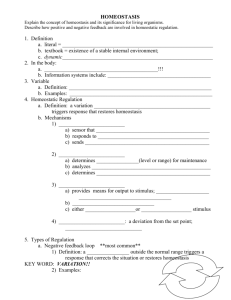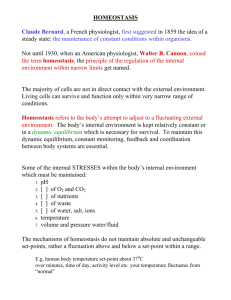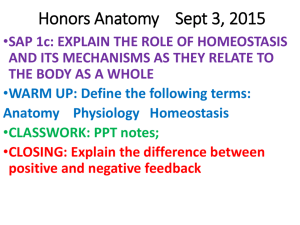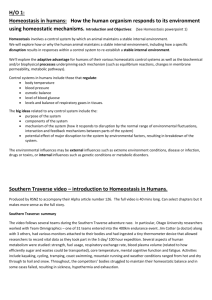August 13th, 2014, DLT's 5-7
advertisement
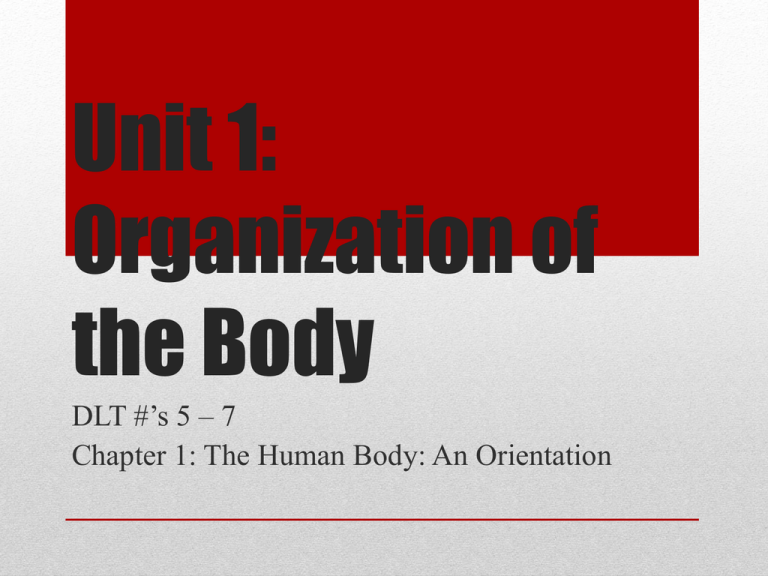
Unit 1: Organization of the Body DLT #’s 5 – 7 Chapter 1: The Human Body: An Orientation • What is homeostasis? • The tendency of an organism or cell to regulate its internal environment and maintain equilibrium. • Usually by a system of feedback controls • To stabilize health and function • The body is generally is homeostasis when its needs are met and it is functioning properly. DLT 5: I can define homeostasis and explain its significance. Homeostatic Control System • The results of the response from the effector feed back to influence the stimulus, either depressing it (negative feedback) so that the whole control mechanism is shut off or enhancing it (positive feedback) so that the reaction continues and is amplified. Negative Feedback Positive Feedback • Almost all homeostatic control mechanisms. • Change the variable back to its original state or “ideal value”. • The exact opposite of a negative feedback mechanism. • The output enhances the original stimulus. DLT 6: I can describe how negative and positive feedback maintain body homeostasis. Negative Feedback Examples Positive Feedback Examples • A home thermostat. The thermostat • contains the receptor (thermometer) and control center. If the heating system is set at 70 degrees Fahrenheit, the heat (effector) is turned on if the temperature drops below 70 degrees Fahrenheit. After the heater heats the house to 70 degrees Fahrenheit, it shuts off effectively maintaining the ideal temperature. • The control of blood sugar (glucose) by • insulin. When blood sugar rises, receptors in the body sense a change . In turn, the control center (pancreas) secretes insulin into the blood effectively lowering blood sugar levels. Once blood sugar levels reach homeostasis, the pancreas stops releasing insulin. Child birth. During labor, a hormone called oxytocin is released that intensifies and speeds up contractions. The increase in contractions causes more oxytocin to be released and the cycle goes on until the baby is born. The birth ends the release of oxytocin and ends the positive feedback mechanism. Blood clotting. Once a vessel is damaged, platelets start to cling to the injured site and release chemicals that attract more platelets. The platelets continue to pile up and release chemicals until a clot is formed. • Most diseases can be regarded as a result of a disturbance to homeostasis, and this is called homeostatic imbalance. • With age our body’s control systems become less efficient, and as a result our internal environments become less stable. • This increases our risk for illness, and produces the changes we associate with aging. DLT 7: I can describe the relationship between homeostatic imbalance and disease. • 1. What process allows us to adjust to either extreme heat or extreme cold? Review • 2. When we begin to get dehydrated, we usually get thirsty, which causes us to drink fluids. Is thirst part of a negative or a positive feedback control system? Be ready to defend your choice. • 3. Why is the control mechanism in this figure called a positive feedback mechanism? What event ends it? • The response leads to an even greater response. • When the clot seals the break in the vessel, the cascade ends.

